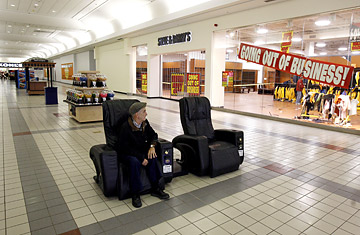
A quiet shopping mall in Danvers, Mass.
It's a brutal time in retail — sales dropped 2.7% in December, the sixth straight month of declines, and 0.1% for 2008, the first annual dip on government records dating back to 1992. It was the worst holiday shopping season in 40 years. Name outlets like Circuit City and Linens 'n Things have gone bankrupt. Who's next? Predicting which companies will go under is a notoriously tricky business, and we won't try that. But here are five struggling retailers whose futures are definitely cloudy, with a look at how they hope to survive. (See the top 10 financial collapses of 2008.)
Talbots
The specialty clothing retailer, which targets women over 35, has run out of steam over the past year. Talbots' same-store sales were down 13.9% in the third quarter of 2008, and the chain lost $14.8 million during that time. "They look dead in the water," says Howard Davidowitz, chairman of Davidowitz & Associates, a retail-consulting and investment-banking firm.
The company's ill-fated $400 million purchase of women's apparel shop J. Jill in 2006 burdened its debt load. "What's hurting them more than anything is that they've got lots of debt on their balance sheet," says Betty Chen, a retail analyst at Wedbush Morgan Securities. Talbots has shuttered its men's, kids and U.K. businesses, and is shopping for a buyer for J. Jill. Good luck finding one in today's market. Earlier this month, investors received some encouragement when the company secured a $150 million credit line from three Japanese banks. In 2008 Talbots also secured a $50 million credit facility from Aeon (U.S.A.) Inc., a wholly owned subsidiary of Japan's Aeon Co. Ltd. and the majority shareholder of Talbots.
"This represents a substantial step forward for Talbots," says company president and CEO Trudy Sullivan. "It stabilizes our liquidity during these most difficult and uncertain times, enabling us to focus on implementing the key strategic initiatives that will drive improved performance of our business." (See who's to blame for the financial crisis.)
Borders
The story of the problems at the country's second largest book retailer is a grim tale. Even before the economic downturn, Borders didn't shine. "Their real estate was suboptimal in some markets, they were overexposed to music and movies, and they tried to go international, which didn't work," says David Schick, an analyst at Stifel, Nicolaus & Co. Then came the financial storm. Total sales dropped 11.7% during the nine-week holiday period that ended on Jan. 3, and sales at stores open for at least a year fell 14.4% during that time. In addition, the company was woefully late to the e-commerce game; it finally launched its own sales site in May (the brand had partnered with Amazon to move books before then). During the 2008 holidays, Borders.com delivered 2.4% of total sales. Comparatively, Barnes & Noble's site regularly delivers 10% of total sales, says Michael Norris, a publishing-industry analyst for research firm Simba Information.
The company switched CEOs this month, hiring Ron Marshall, a turnaround specialist and former Barnes & Noble executive. "Borders remains one of the nation's strongest brands with millions of loyal customers who love our stores," says company spokeswoman Anne Roman. "Our new leadership recognizes our challenges, admits that we have made mistakes, and is focused on getting our financial house in order as an immediate priority." Borders stock has flirted with a New York Stock Exchange delisting; it closed at 52 cents per share on Jan. 27, a 95% drop over last year. "They're in survival mode," says Davidowitz. But how can the company stay afloat when the economy has turned against the whole industry (even Barnes & Noble is struggling), and when big boxes like Walmart and Target are moving into the book-selling game? "Borders has to give people a reason to shop there," says Norris, starting with improving customer service. "It has to be more than better," he says. "It has to be astronomical. It has to be something people talk about." (Read "Books Gone Wild: The Digital Age Reshapes Literature.")
Pier 1 Imports
The stock of the home accessories retailer is also perilously close to a delisting. Pier 1 was trading at 45 cents on Jan. 27, down 92% over the past 12 months. The real estate crash has been devastating to all home-furnishing retailers, but like Borders, Pier 1 wasn't performing well even before the collapse. "Merchandising was stale, they were relying too much on selling wicker furniture, the price points were probably too high and there was store saturation," says Anthony Chukumba, an equity analyst at FTN Midwest Securities Corp. (See pictures of Americans in their homes.)
The company has reported just one profitable quarter over the past two years. The third quarter of 2008 was devastating: Pier 1 lost $36.9 million, or 41 cents per share, on $300.9 million in revenue. That loss far exceeded analysts' expectation of 26 cents per share. Chukumba says Pier 1 CEO Alex Smith has made some smart moves, like stocking shelves with small items, which consumers are more likely to buy on impulse. "Unfortunately, the macro economic environment more than overshadows that," he says.
Chukumba thinks Pier 1 has enough cash and a small enough debt load to weather this recession for a couple of years at best. "But if things get worse real fast or the recession lasts for even a longer period of time, I have to call Pier 1's viability into question," he says.
